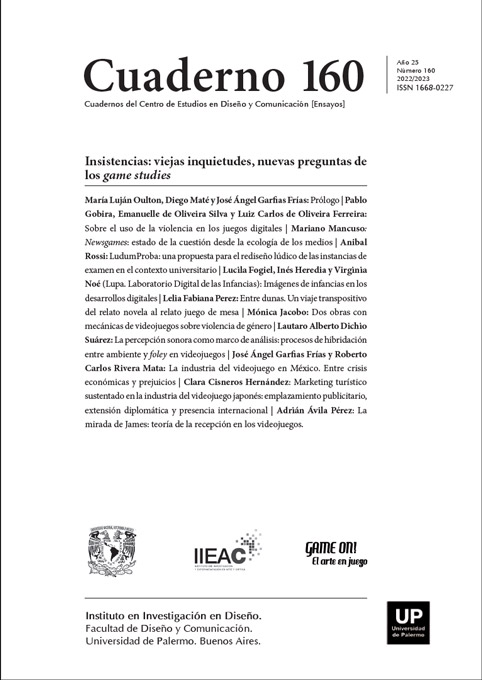Dos obras con mecánicas de videojuegos sobre violencia de género
Abstract
The possibility of inhabiting someone else’s skin as well as entering symbolic spaces in three dimensions, constructed with the materiality of polygons, is used not only for entertainment but also for the development of games involving social criticism. According to Judith Wajcman’s proposal (2006), technologies are composed not only by material elements, but also with the discursive and social elements of techno-scientific practice. In this work, we delve into two productions that at the discursive level guide the critical view on the relationship between gender and videogames, Sola by Agustina Isidori and Memento de Marlow Haspert, experiences that dive into problems of gender violence through video games language.
References
Bennett, A. y Peterson, R. (2004). Music Scenes: Local, translocal, and virtual. Tennesse: Vanderbilt University Press.
Casell, J. y Henry J. W. (1998). From Barbie to Mortal Kombat. Gender and omputer games. Cambridge: MIT Press.
Cevedio, M. (2010). Arquitectura y género. Espacio público/espacio privado. Colección mujeres voces y propuestas. Barcelona: Icaria.
Chess, S. (2016). The queer case of video games: orgasms, Hheteronormativity, and video game narrative. En Critical studies in media communication, (33)84-94
Clark, A. y Mitchell, G. (2007). Videogames and Art. Bristol: Intellect.
Consalvo, M. (2008). Crunched by passion: women game developers and workplace challenges. En Kafai J., Heeter C., Denner J. y Sun, J. (eds) Beyond Barbie and Mortal combat.
New perspectives on gender and gaming. Massachusetts: MIT Press. 177-192.Flanagan, M. (2009). Critical Play: Radical Game Design. Cambridge: MIT Press
Gray, K., Voorhees G. y Vossen E. (2018). Feminism in Play. Londres: Palgrave Macmillan.
Hayes, E. (2008). Girls, gaming and trayectories in IT expertise. En Kafai J., Heeter C., Denner J. y Sun, J. (eds) Beyond Barbie and Mortal Kombat. New perspectives on gender and gaming. Massachusetts: MIT Press. 217-230.
Huizinga, J. (1984). Homo ludens. Madrid: Alianza. Isidori, A. y Brunell-Lecrerc E. (2017). Representing femicide through a video game: towards a socially responsible design practice. Recuperado de https://www.agustinaisidori.com/sola
Jacobo, M. (2017). Procesos de formación y consolidación de un mundo de arte digital: el caso de las artes visuales en Córdoba (1996/2007). Tesis de Doctorado en Artes, Inédita. Facultad de Artes, UNC.
Lagarde, M. (2006). Del femicidio al feminicidio. Desde el Jardín de Freud, (6). 216–225. https://revistas.unal.edu.co/index.php/jardin/article/view/8343
Maté, D. (2019). Walking simulator: los caminos del videojuego y el arte. Panambí. Revista De Investigaciones Artísticas, (9). 19-31.
Mejía, R. y Lesavoy, B. (2018). The sexual politics of video game graphics. En Gray, K., Voorhees G. y Vossen E. (eds) Feminism in Play. Londres: Palgrave Macmillan. 83-102.
Miranda, L. (2021). Giocare a caminare. San Francisco: Concrete Press.
Molina Petit, C. (1994). Dialéctica feminista de la Ilustración. Barcelona: Anthropos.
Oulton, L. (2021). Videojuegos en el museo. Nuevos desafíos curatoriales. Cuadernos del Centro Estudios en Diseño Comunicación, 98. 74-87.
Prescott, J. y Bogg, J. (2014). Gender divide and the computer game industry. Londres: Information Science.
Ruberg, B. y Shaw, A. (2017) Queer game studies. Minneapolis: University of Minnesota Press.
Sharp, J. (2015). Works of Game: On the Aesthetics of Games and Art. Cambridge: MIT Press.
Vergés Bosch, N. (2013). Teorías feministas de la tecnología: evolución y principales debates. Barcelona: Universitat de Barcelona.
Wajcman, J. (2006) El Tecnofeminismo. Valencia: Cátedra.
Wajcman, J. (2010). Feminist Theories of Technology. Cambridge Journal of Economics, 34(1), 143–152.
Los autores/as que publiquen en esta revista ceden los derechos de autor y de publicación a "Cuadernos del Centro de Estudios de Diseño y Comunicación", Aceptando el registro de su trabajo bajo una licencia de atribución de Creative Commons, que permite a terceros utilizar lo publicado siempre que de el crédito pertinente a los autores y a esta revista.


